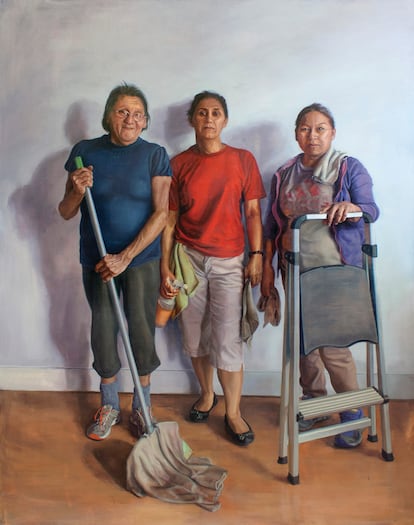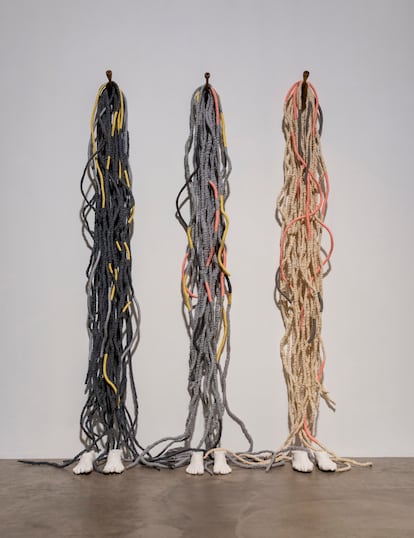At the National Museum of Women in the Arts in the US capital, there is a life-size marble sculpture of a woman that is striking at first sight. Instead of a breast, the figure has a marked scar, evidence of having undergone a mastectomy. Spanish artist Marina Vargas used herself as a model to create the piece, called Intra-Venus, after she was diagnosed with breast cancer during the pandemic and had to undergo surgery. With this work, she wants to “show vulnerability and fear as driving forces,” she explains. Vargas is one of the Hispanic artists included in the exhibition New Worlds, Women to Watch in 2024on view until August 11 at the museum in Washington, DC
Among the Hispanic women chosen to participate in this exhibition are Argentine, Chilean, Peruvian, Venezuelan, Mexican and Spanish artists. They all seek to show their own vision of the world, reflecting their perspective on issues such as the pandemic, gender equality, immigration, the environment and social justice. The exhibition, directed by curators Virginia Treanor and Orin Zahra, “speaks of envisioning the future while being in the present,” explains Vargas.
The Andalusian artist says that two months before the lockdown caused by the Covid pandemic, she was diagnosed with breast cancer and had to live in isolation, undergoing a treatment that was already hard. That is why she decided to investigate artists who had gone through the same thing and chose to continue a previous project on canons. “At that moment I realized that I had broken the canon of beauty. Undressing in front of strangers was assuming my own new normality,” she admits. This is how her work was born. Intra-Venus. The figure’s left arm is raised in the sculpture, symbolising the recovery Vargas had to endure after the operation. Raising the limb was a difficult task for her, she recalls. The material chosen was Carrara marble, typical of Greco-Roman sculptures that instilled the canons of beauty that survive to this day.
Vargas explains that this exhibition empowers female artists, whose presence in the art world does not reflect the extent of their work. “In places that legitimize us, such as museums, the percentage of women is a minority,” she says.
Located in downtown Washington, in a building built as a Masonic temple in 1908, the National Museum of Women in the Arts (NMWA) was closed for renovation for three years. In October of last year, it reopened with the same purpose for which it was founded in 1981: to give visibility to women artists, who are underrepresented in cultural circuits. The seventh edition of New Worlds, which the museum organizes every three years, It has also served to create links between the artists, Vargas adds, especially with Hispanic ones. Each artist has been selected by one of the national and international committees of the NMWA network.
The representation of the immigrant woman
The theme of immigration, latent in most of the families of Latina artists, emerges as a protagonist in several of the works exhibited. The Mexican Arely Morales, portrays in her painting One by one Three Latin American immigrant women in large format, reserved for real, mythological or religious subjects. With determination and a fixed gaze, the three women hold cleaning supplies, defying the unwritten rules that render invisible people, usually immigrants, who do jobs like theirs.

The Venezuelan Saskia Jordá also dedicates her work Estate to the migrant women in her family. Three sets of intertwined cotton ropes hang from the wall, resting on three pairs of plaster feet. The ones in the middle represent the artist herself, who is flanked by those emulating her two grandmothers. The ropes draped over the feet reflect the roots that people take with them when they emigrate to another country.

Peruvian artist Graciela Arias Salazar exhibits 10 machetes painted with scenes from the mythology of indigenous Amazonian cultures. The work tells a story of how the inhabitants of the region learned to connect with plants, animals and spirits.
The fight for women’s rights
Chilean Daniela Rivera exhibits 1033 boats from the series She never kicked the ballinspired by the women of Chuquicamata, Chile. The work is the result of three years spent by Rivera interviewing residents of this town, located next to a copper quarry in the Andes mountains, and in a video she tells their story. The story is a chronicle of success in the fight for gender equality.
The women of the community were excluded from all the benefits and social protections offered to their husbands, who were employed at the mine. To gain visibility, they formed a soccer team, although they never played, and founded the Corporation of Women Copper Workers. This allowed them access to education, technical
training, and other social protections. Women gained representation, and the main local union accepted the candidacy of a woman. Mirta Moreno became the first president of the copper workers’ union, which with 4,000 workers is the largest in the country.
“For me, New Worlds “It means rethinking ways to achieve social justice. Freedom is found in the collective rather than in the individual,” Rivera says.
Also Chilean, Francisca Rojas Pohlhammer raises the issue of gender equality in her work Universalis Cosmography. Forming a chakanaa cross used by the Incas and other ancient Andean cultures, Rojas places female figures like those traditionally made by generations of women in Quinchamalí, Chile, replacing the guitar with a weapon. Setting them in a predominantly male environment such as the Army, the figures surround a drone, a device used in current wars.
For her part, the Argentine Ana María Hernando presents her work Swimming in the flood of warm waters, a A display of colorful tulle in which light and air recall a woman’s clothing. Another Argentine, Irina Kirchuk, chooses abstraction in her work Tetris IIInspired by the bars that cover the windows and doors of buildings in Buenos Aires, she creates a montage of geometric figures in different shades of red in which discarded materials show the beauty of the city’s debris.
#immigration #gender #equality #Hispanic #artists #share #worldview #Washington